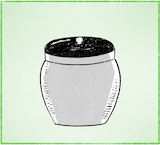
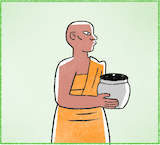
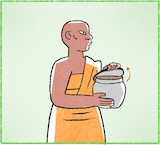
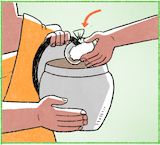
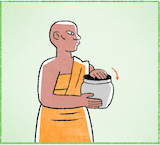
อันนี้คืออี่หยัง อันนี้เบิ่งซงแล้วกะสิเป็นบาดเนาะ เป็นบาดพะ บาดพะหนิหละ
บาดนี้มีหน้าที่หนะเอาไว้เฮ็ดหญัง พะกะสิมี กะสิเอาบาดนี้ไปไว้ถ้าบินทะบาดญามมื้อเซ้าเนาะ บินทะบาดอยู่นำหมู่บ้าน หลือว่าเอาไว้ถ้าใส่แนวกินกับชาวบ้านที่เอามาถะหวาย หลือว่าเอามาให้เนาะ กะสิเอาใส่บาดนี้ เป็นพาชะนะหลือว่าแนวที่สิใส่กับเข้ากับน้ำที่เพิ่นเอามาให้ หลือว่าชาวบ้านเอามาให้มาทานเนาะ
12
อันนี้คืออี่หยัง อันนี้กะเป็นพะเนาะ
เป็นพะลูบหนึ่ง กำลังถือบาดอยู่
จักว่าถืออยู่ใส อาดสิอยู่ในวัดหลือว่ากำลังญ่างบินทะบาดกะได้
ขั้นสิไปบินทะบาดหนิ สิไป[บินทะบาด]จั่งใด สิบินทะบาดจั่งใด กะไปบินทะบาดญามมื้อเซ้า ปะมานหกโมงเซ้าเนาะ หลือว่าตีห้า เพื่อที่สิไปบินทะบาดลอบหมู่บ้าน เพื่อที่สิให้ชาวบ้านชาวเอ่ยเนี้ย มาถะหวายเข้าถะหวายน้ำกับพะลูบนี้เนาะ
แล้วตอนนี้พะกำลังใส่อี่หยัง กะกำลังใส่ เขาเอิ้นว่าจีวอนเนาะ จีวอนสีส้ม
จีวอนนี้มีสีหญังแน่ กะแล้วแต่ว่าสีที่มันเป็น สีค้ายๆ กับ โทนเดียวกันกับสีส้มเนาะ อาดสิเป็นสีส้ม สีเหลียง สีน้ำตานแก่ หลือว่าสีแดงแก่ สีแดงอ่อน กะแล้วแต่เนาะ เอากะสิปะมานนี้ สีโทนเดียวกันปะมานนี้เนาะ
แล้วพะเป็นหญังต้องโกนหัวโล้น อันนี้กะบ่แน่ใจกันเนาะ แต่ว่ากะ ฮู้แต่ว่าพะซู่องซู่ลูบเนาะกะต้องโกนหัวโล้น
13
พะลูบนี้กำลังเฮ็ดหญัง กำลังเปิดฝาบาด
เป็นหญังเขา เป็นหญังเพิ่นต้องเปิดฝาบาด กะอาดสิมีชาวบ้านหลือว่าพุคนมาถะหวายเข้าถะหวายน้ำในบาดนี้ เพิ่นกะเลยต้องเปิดบาด เพื่อที่สิลับเข้าลับน้ำจากชาวบ้านเนาะ
14
อันนี้กำลังเฮ็ดหญังอยู่ พะเนาะกำลังเปิดฝาบาดขึ้น เพื่อที่สิลับเข้าลับน้ำจากชาวบ้าน หลือว่าลับอาหานจากชาวบ้านที่เอามาถะหวาย กะสิมีชาวบ้าน หลือว่า เอิ้นว่ายาดโย๊มเนาะ มาถะหวายเข้าถะหวายน้ำในบาดนี้ กำลังยื่นแนวกิน หลือว่าเอาเข้าใส่ไปในบาดเนาะ
Link to overview page
Link to dictionary
| Isaan | Pronunciation | Tones | Thai | English/Notes |
|---|---|---|---|---|
| อัน | an | M | อัน | 1. thing, object 2. general clf. for objects |
| นี้ | ni: | HF | นี้ | 1. this 2. here |
| คือ | khʉ: | HR | คือ | 1. to be, to resemble, like, as 2. why {บักหล้าคือบ่เก็บโต่ะแน่ = [addressing a young boy] Why haven't you cleared the table?} |
| อี่หยัง | i:-yaŋ | H-M | อะไร | 1. what {นี้คืออี่หยัง = What is this?} {มื้อนี้เจ้าเฮ็ดอี่หยัง = What are you doing today?} {กินเข้างายกับอี่หยัง = What did you have for breakfast?} 2. something, anything, (in negations) nothing {บ่ต้องเฮ็ดอี่หยังอีกเลยนอกจากใส่ปุย = [we] don't need to do anything besides adding fertilizer} |
| เบิ่ง | bəŋ | H | ดู | 1. to look at, to see, to watch {เบิ่งโทละทัด = to watch TV} {เบิ่งหนัง = to watch a movie} 2. to guess {เบิ่งซงแล้ว ... = [I] guess / from what it looks like ...} |
| ซง | soŋ | HR | ทรง | 1. shape, form 2. as if, like Notes: translation to be confirmed |
| แล้ว | lɛ:o | HF | แล้ว | 1. finished 2. already 3. and then, and next (especially แล้วกะ) 4. auxiliary for past tense |
| กะ | ga | M | ก็ | 1. then, consequently 2. also |
| สิ | si | M | จะ | future tense auxiliary {เขากำลังสิตื่น = he's about to wake up} {สิไปตะหลาด = [I'm] going to the market} |
| เป็น | pen | M | เป็น | 1. to be, to exist 2. to be able to 3. to suffer, sth. happens to 4. เป็นหญัง[...]คือ in initial position: why? {เป็นหญังเขากะคือแปงฟัน = Why is he brushing his teeth?} {เป็นหญังเคี่ยงบินมันคือสิตก = Why is the airplane falling down?} |
| บาด | ba:t | LF | บาตร | alms bowl {ใส่บาด = to put food offerings in a Buddhist monk's alms bowl} |
| เนาะ | nɔ | H | เนาะ | final particle: makes the statement softer, looking for agreement |
| พะ | pha | H | พระ | monk |
| หนิหละ | ni-la | M-M | นี่แหละ | auxiliary for emphasis at the end of a phrase Notes: variant of นี้หละ |
| มี | mi: | HR | มี | 1. to have 2. there is |
| หน้าที่ | na:-thi: | LF-H | หน้าที่ | duty, responsibility, obligation, function |
| หนะ | na | M | final particle | |
| เอา | ao | M | เอา | to take, to give {เขากำลังเอาก่องไปซั่ง = he's taking the boxes to weigh them} {หมอกำลังเอายาให้คนป่วยกิน = the doctor is giving medicine to the patient} {เอาไว้ถ้า = is for, is used for, has the purpose of} |
| ไว้ | wai | HF | ไว้ | 1. to keep, to put, to place, to retain, to save, to reserve {เขาเอาหัวของเขาไว้ใส = Where does she put her head?} {หมาสิเลี้ยงไว้บ้าน = dogs are kept/raised in the house} {ไก่เลี้ยงไว้ในคอก = chicken are kept/raised in a coop} {หน้ามันบังไว้ = the face is covered/not visible} {เขาเอาโทละสับวางไว้หู = he holds the phone to his ear} 2. for {นาลิกาปุกมีไว้เฮ็ดหญัง = What is an alarm clock for?} {หม้อเอาไว้เฮ็ดแนวกิน = a pot is used to make food} {ก่องเอาไว้เฮ็ดหญัง ก่องเอาไว้ใส่ของ = What is the box for? It's for putting in stuff.} Notes: see also ไว้ถ้า |
| เฮ็ด | het | H | ทำ | to do, to make |
| หญัง | ɲaŋ | M | อะไร, เป็นหญัง = ทำไม | 1. what {เขากำลังเฮ็ดหญัง = What is he doing?} {ธูปเอาไว้เฮ็ดหญัง = What are incense sticks for?} 2. something, anything, (nothing) 3. เป็นหญัง[...]คือ in initial position: why {เป็นหญังเขาคือใส่บักพิกลงไปในกวยเตียว = Why is he putting chili in [his] noodle soup?} {เป็นหญังหน้าต่างมันคือเปิด = Why is the window open?} {เป็นหญังมันคือมีควนไฟ = Why is there smoke?} |
| ไป | pai | M | ไป | 1. to go 2. auxiliary indicating action extending into the future |
| ไว้ถ้า | wai-tha: | HF-LF | usually in a positive statement or answer: is for, is used for, has the purpose of {กะทะมีไว้ถ้าทอด = a pan is for frying} {น้ำบักนาวมีไว้ถ้าปุงอาหาน = lime juice is used to season food} {ปากกามีไว้ถ้าเขียน = a pen is for writing} {กะเทียมเอาไว้ถ้าเฮ็ดแนวกิน = garlic is used to make food} {ขาเอาไว้ถ้าญ่าง = legs are for walking} {เกิบเอาไว้ถ้าใส่ = shoes are for wearing} Notes: see also ไว้ |
|
| บินทะบาด | bin-tha-ba:t | M-H-LF | บิณฑบาต | (of a monk) to go with a bowl to receive food offerings |
| ญาม | ɲa:m | HR | ยาม | 1. period of time {ญามมื้อเซ้า = morning} {ญามเที่ยง = noon} 2. when, while {ญามทอด ต้องใซ้น้ำมันพ้อม = one needs to use oil when frying} {ญามสิออกไปข้างนอกกะต้องใส่เกิบ = when one goes out, ones has to wear shoes} |
| มื้อเซ้า | mʉ:-sao | HF-HF | เช้า | morning |
| อยู่ | yu: | H | อยู่ | 1. to be (located) at 2. yet, still 3. auxiliary indicating continuous or progressive action {ทอดปาอยู่ในกะทะ = (in the process of) frying a fish in the pan} {แม่กำลังเมี้ยนเฮียนอยู่ = mother is cleaning/tidying up the house} |
| นำ | nam | HR | 1. at, in 2. with, together with {บ่สามาดถือไปนำได้ = [you] can't carry it around} {กินบักแตงโมนำเฮาบ่ = Will you eat watermelon with me?} 3. to lead, to accompany, to go with {เด็กน้อยญ่างไปนำแม่ = the daughter follows her mother} |
|
| หมู่บ้าน | mu:-ba:n | H-HF | หมู่บ้าน | village |
| หลือ | lʉ: | M | หรือ | or |
| ว่า | wa: | H | ว่า | 1. that, as {คำว่า X = the word X} 2. to say |
| ใส่ | sai | H | ใส่ | 1. to put something in/on {เขาใส่บักพิกในกวยเตียวหลาย = he's putting a lot of chili in his noodle soup} {เขาบีบยาสีฟันใส่แปงสีฟัน = he squeezes toothpaste on the toothbrush} {ก่องเอาไว้ใส่ของ = boxes are there to put stuff in} 2. to wear (clothes) {เขาใส่เสี้ยแขนญาว = he's wearing a long-sleeve} 3. directed at {เอิ้นใส่กัน = to call each other/to say to each other} {หมามันเห่าใส่แมว = the dog barks at the cat} {ล้องเพงใส่ไม = to sing into the microphone} {เขากำลังซี้มือไปใส่พุซาย = she's pointing at the man} |
| แนวกิน | nɛ:o-gin | HR-M | อาหาร | food {เฮ็ดแนวกิน = to prepare food} {ตำบักหุ่งเนี้ยกะสิเป็นแนวกิน = papaya salad is (a kind of) food} |
| กับ | gap | M | กับ | 1. and {ลุงกับป้า = uncle and aunt} {กวยเตียวหมูกับกวยเตียวไก่ = noodle soup with pork and noodle soup with chicken} 2. with, to {ค้ายๆ กับคำว่า ... = similar to the word ...} 3. prefix in front of foods {กับเข้า = side dishes eaten with rice} {เขากินกับกวยเตียว = he's eating noodle soup} |
| ชาวบ้าน | cha:o-ba:n | HR-HF | ชาวบ้าน | villager Notes: pronunciation: also realized as ซาวบ้าน |
| ที่ | thi: | H | ที่ | 1. that, which {คนที่ยืนอยู่ฝั่งขวา = the person which is standing on the right = the person standing on the right} {เว้าคำที่บ่สุพาบ = to speak words which are impolite = to speak impolitely} 2. for ordinal numbers {ที่สาม = third} |
| มา | ma: | HR | มา | 1. to come 2. auxiliary expressing action towards the present or focal time {กะคุเฮ็ดมาจากอี่หยัง = What is the bucket made of?} {แล้วเขากะเก็บเงินจากพุนั้นมา = and then she takes the money of that person} |
| ถะหวาย | tha-wa:i | M-M | ถวาย | to offer, present |
| ให้ | hai | LF | ให้ | 1. to give {หมอกำลังเอายาให้คนป่วยกิน = the doctor is giving the patient medicine} 2. for 3. to allow, to be allowed |
| พาชะนะ | pha:-cha-na | HR-H-H | ภาชนะ | container, utensil, receptable |
| แนว | nɛ:o | HR | 1. kind, sort, type 2. method, mode of action - and the corresponding tool or object, thing {แนวนุ่งห่ม = clothes, clothing} {แนวคม = sharp object [e.g., a pair of scissors]} {แนวถือ = handle} 3. clf. for words starting with แนว {กินแนวอันนั้น = กินแนวกินอันนั้น = to eat this food [which was talked about earlier]} |
|
| เข้า | khao | LF | ข้าว | rice {กินเข้า = to eat} {ปูกเข้า, เฮ็ดเข้า = to grow/plant rice} {เกี่ยวเข้า = to harvest rice} {กับเข้า = courses eaten with rice} |
| น้ำ | na:m | HF | น้ำ | 1. water 2. drink, soft drink, juice |
| เพิ่น | phən | H | คนอื่น, เขา, ท่าน | 1. someone, somebody 2. he, she, they 3. 3rd person pronoun used with Buddhist monks Notes: polite |
| ทาน | tha:n | HR | ทาน | to give, offer, present |
| ลูบ | lu:p | HF | รูป | clf. for monks |
| หนึ่ง | nʉŋ | H | หนึ่ง | 1. one 2. after adjective: intensifier {บักคักหนึ่ง = very much} {อันบักใหญ่หนึ่ง = very large}, or attenuates the meaning {กะดาดมันแผ่นน้อยๆ หนึ่ง = the piece of paper is [relatively] small} |
| กำลัง | gam-laŋ | M-HR | กำลัง | auxiliary indicating continuous or progressive action |
| ถือ | thʉ: | M | ถือ | 1. to hold 2. to carry 3. to regard as, to consider {สี่สิบองสาถือว่าฮ้อน = 40 degrees Celsius is considered hot} |
| จัก | jak | M | จัก | 1. answer to a question: [I] don't know, don't know exactly, [I'm] not sure {พุซายคนนี้เขาเถ้าไป่ จัก จักเถ้าหลือบ่เถ้า เบิ่งบ่ค่อยออก = Is this man here already old? I don't know. I can't see clearly whether he's old or not.} {เขาเว้ากันอยู่ใส จักคือกัน = Where are they talking? I don't know either.} 2. exact(ly), what exactly {จักต้มอี่หยังกะบ่ฮู้ = I don't know what (exactly) he is cooking} {บ่ลู้คือกันจักปาอี่หยัง = I don't know either what kind of fish this is} 3. how much/many? {ต้นไม้มีจักต้น = How many trees are there?} {ตอนนี้จักโมงแล้ว = What time is it now?} {มือของเฮานี้สิมีจักนิ้ว = How many fingers do our hands have?} 4. a bit, a little bit {จักหน่อย/จักหน่อยหนึ่ง = a bit, a little bit} |
| ใส | sai | M | (ที่)ไหน | 1. where? {สิไปใส = Where are [you] going?} {มาแต่ใส = Where are [you] coming from?} {กะทะอยู่ใส = Where's the pan?} 2. somewhere, anywhere {ใสกะได้ = anywhere, wherever you like} |
| อาด | a:t | LF | อาจ | 1. might, may, will 2. likely |
| ใน | nai | HR | ใน | in, within |
| วัด | wat | H | วัด | temple, Buddhist temple |
| ญ่าง | ɲa:ŋ | H | เดิน | to walk {เขากำลังญ่างเว้ากัน = they are walking and talking} {ลูกเป็ดญ่างไปนำแม่เป็ด = the ducklings are [walking] following their mother} {เขากำลังญ่างข้ามสะพาน = she's walking over the bridge} {เขาสิญ่างไปใส = Where is he going?} |
| ได้ | dai | HF | ได้ | 1. can 2. to get, to obtain 3. before verb: indicating past tense 4. บ่ได้ + verb: not |
| ขั้น | khan | LF | เมื่อ | when, if |
| หนิ | ni | M | นี่แหละ, เหรอ/หรอ | 1. particle used to emphasize a statement or form (or add to) a question {เป็นตาแซบคือหญังหนิ = it's really tasty} {เคี่ยงพอเท่าๆ หนิ = the [radio] is appropriately sized (i.e., not too large)} 2. variant of นี้ = this Notes: translation to be determined; maybe sometimes like Thai นี่แหละ; other examples given: อยู่ใสหนิ อยู่ตลาดหนิ กินเข้าไป่หนิ |
| จั่งใด | jaŋ-dai | H-M | ยังไง, แบบไหน | how, in what manner {บักนาวมันมีลดซาดจั่งใด = Lime fruits have what kind of taste?} {เขาปิดแอจั่งใด = How is he switching off the A/C?} {เทียนใซ้จั่งใด = How's a candle used?} {สิใซ้จั่งใด = how is [it] used?} |
| ปะมาน | pa-ma:n | M-HR | ประมาณ | 1. about, approximatively 2. to guess, to estimate |
| หก | hok | M | หก | six |
| โมง | mo:ŋ | HR | โมง | o'clock, hour {ตอนนี้เวลาจักโมงแล้ว = What time is it?} {ตอนนี้เวลาห้าโมงเคิ่ง = It's half past five.} |
| เซ้า | sao | HF | เช้า | morning Notes: see also มื้อเซ้า, เข้าเซ้า |
| ตี | ti: | M | ตี | 1. to hit 2. an hour counting after midnight {ตีห้า = 5 a.m.} |
| ห้า | ha: | LF | ห้า | five |
| เพื่อที่ | phʉ:a-thi: | H-H | เพื่อที่ | in order to, so that Notes: the vowel เอือ is likely to be a Thai loan |
| ลอบ | lɔ:p | HF | รอบ | around |
| ชาว | cha:o | HR | ชาว | general term for residents, citizens, inhabitants, people |
| เอ่ย | ə:i | H | generic term in reduplications, e.g., เด็กน้อยเด็กเอ่ย, เป็นแผเป็นเอ่ย, เฮ็ดตาเฮ็ดเอ่ย, มีหญ้ามีเอ่ย, เฮ็ดบ้านเฮ็ดเอ่ย | |
| เนี้ย | ni:a | HF | เนี้ย | variant of นี้ = this, here |
| ตอนนี้ | tɔ:n-ni: | M-HF | ตอนนี้ | now |
| เขา | khao | M | เขา | personal pronoun: he, she |
| เอิ้น | ə:n | HF | พูด, เรียก | to call, to say {เอิ้นง่ายๆ ว่า = in other words} {คนอี่สานเอิ้นว่า เป็นลูกคนกก = Isaan people call her ลูกคนกก} |
| จีวอน | ji:-wɔ:n | M-HR | จีวร | robe of a Buddhist monk |
| สี | si: | M | สี | 1. color 2. colored pencil, crayon |
| ส้ม | som | LF | ส้ม | 1. fruit: orange 2. color: orange |
| แน่ | nɛ: | H | แน่, บ้าง | 1. some, somewhat 2. final particle, used to ask for examples (similar to Thai บ้าง at the end of a question) {หม้อใซ้เฮ็ดอี่หยังได้แน่ = What (different things) can a pot be used for?} {น้ำอัดลมซื้อได้อยู่ใสแน่ = Where/in which places can one buy soft drinks?} 3. final particle, when giving examples {มีเทิงส้งแน่ มีเสี้ยแน่ มีเกิบแน่ = there are trousers, shirts, shoes etc.} 4. final particle, used to give a command {ไปปิดหน้าต่างให้แน่ = Close the window!} 5. final particle, acting as an intensifier, especially in the pattern ... คัก ... แน่ {สูงคักสูงแน่ = very high} {ญ้องเฮาคัก ญ้องเฮาแน่ = [he's] praising me a lot} |
| แล้วแต่ | lɛ:o-tɛ: | HF-H | แล้วแต่ | up to, depending on |
| มัน | man | HR | มัน | it (also used to refer to people) |
| ค้าย | kha:i | HF | คล้าย | to resemble, to be similar, to be alike {ทัพพีเป็นค้ายๆ กับซ้อน = a ladle is similar to a spoon} |
| โทน | tho:n | HR | โทน | tone (of colour), hue |
| เดียวกัน | di:ao-gan | M-M | เดียวกัน | same |
| เหลียง | li:aŋ | M | เหลือง | yellow |
| น้ำตาน | na:m-ta:n | HF-M | น้ำตาล | color: brown |
| แก่ | gɛ: | H | แก่ | 1. old 2. dark |
| แดง | dɛ:ŋ | M | แดง | red |
| อ่อน | ɔ:n | H | อ่อน | 1. soft 2. young |
| ต้อง | tɔŋ | HF | ต้อง | to have to, must |
| โกน | go:n | M | โกน | to shave |
| หัว | hu:a | M | หัว | 1. head 2. clf. for onions, bulbs of garlic |
| โล้น | lo:n | HF | โล้น | bald, hairless, shaven |
| บ่ | bɔ: | H | ไม่ | 1. no, not 2. question particle, transforming a statement into a question Notes: spelling exception in line with common usage on social media |
| แน่ใจ | nɛ:-jai | H-M | แน่ใจ | to be sure, confident, certain |
| กัน | gan | M | กัน | mutual, each other, with another, together {เขากำลังนั่งเว้ากัน = they're sitting and talking} {เขาสองคนฮักกัน = they love each other} {ปาสองโตนี้ ใหญ่ห่างกันหลายบ่ = These two fish here, are they very different in size (from each other)?} {ต่างกัน = to be different (from each other)} {ก่องอันไหนหนักกว่ากัน = Which box is heavier (than the other(s))?} |
| แต่ว่า | tɛ:-wa: | H-H | แต่ว่า | 1. but 2. only {ฮู้แต่ว่าเขายืนอยู่พุเดียว = I only know that he's standing there by himself} |
| ฮู้ | hu: | HF | รู้ | 1. to know 2. to understand Notes: equivalent to ลู้ |
| ซู่ | su: | H | 1. all, entire 2. every, any {ซู่พุซู่คน = everybody} {ซู่สิ่งซู่อย่าง = everything} {ไก่ต้องกินเข้าซู่มื้อ = chicken need to eat every day} {ซู่คนสิมีขาเอาไว้ถ้าญ่าง = everybody has legs to walk} |
|
| อง | oŋ | M | องค์ | clf. for monks |
| เปิด | pə:t | M | เปิด | 1. to open {เปิดหน้าต่าง = to open the window} {เปิดปะตู = to open the door} 2. to start, to switch on {เปิดไฟ = to switch on the light} {เปิดแอ = to switch on the A/C} |
| ฝา | fa: | M | ฝา | 1. lid {ฝากะปุก = lid of a jar/pot} 2. wall {ฝาบ้าน = wall (of a house) = กำแพงบ้าน} |
| พุ | phu | H | ผู้ | 1. person 2. clf. for people {พุหญิงพุหนึ่ง พุซายพุหนึ่ง = a woman, a man} {ซู่พุซู่คน = everybody} {พุหนึ่งโตจ่อยๆ พุหนึ่งโตบักอ้วนหนึ่ง = one person is slim, the other is fat} Notes: pronunciation: also realized as พู่- |
| คน | khon | HR | คน | person, people |
| เลย | lə:i | HR | เลย | 1. futher on, beyond, past {เข็มน้อยเลยเลขสิบสองไป = the minute hand has passed number twelve} 2. too much 3. at all 4. definitively 5. completely, utterly |
| ลับ | lap | H | รับ | 1. phone: to answer a call 2. to receive, accept, pick up, take up Notes: see also ฮับ |
| จาก | ja:k | LF | จาก | 1. from {... เฮ็ดมาจากอี่หยัง = ... is made from what?} 2. to depart |
| ขึ้น | khʉn | LF | ขึ้น | 1. to go up, to increase 2. sun: to rise {ตะเว็นกำลังขึ้น = the sun is rising} 3. more 4. bus/train etc.: to get on, to board {พุโดยสานขึ้นลดไฟเบิดแล้ว = all passengers have boarded the train} |
| อาหาน | a:-ha:n | M-M | อาหาร | food {ญุงมันกินเลียดเป็นอาหาน = the mosquito feeds on blood} |
| ยาดโย๊ม | ya:t-yo:m | HF-HR | ญาติโยม | clerical word for laymen who engage in Buddhist practice like alms giving or making merit |
| ยื่น | yʉ:n | H | ยื่น | to hand sth. to so., to stretch out one's hand, to reach out for {เขากะสิยื่นแตงโมให้พุซายกิน = she hands the boy watermelon to eat} |